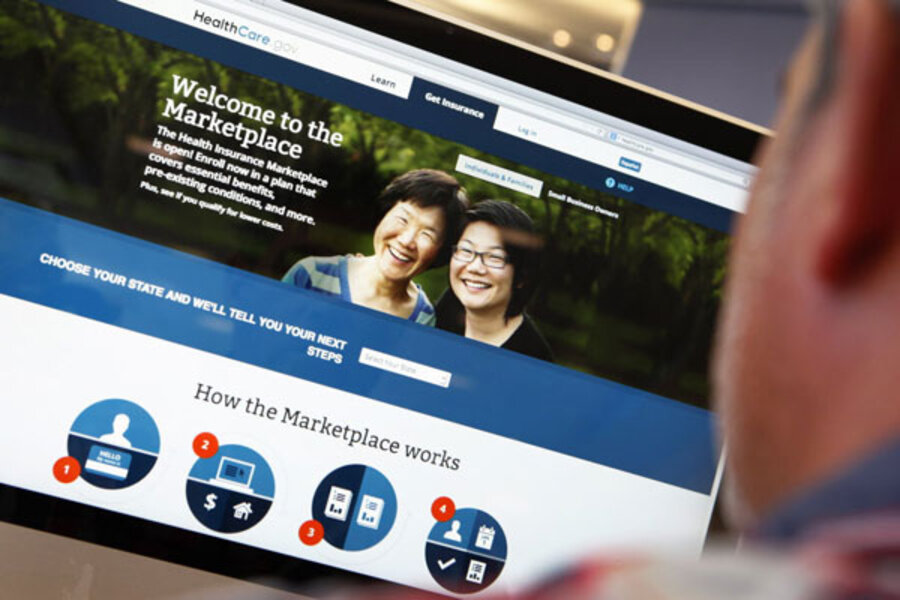Obamacare website is supposed to work now. Is it ready for a surge in use?
Loading...
| Washington
Get ready to find out what it means for the Obamacare website to “work smoothly for the vast majority of users.”
That was the phrase used a month ago by Jeffrey Zients, tapped by President Obama to lead a “tech surge” to fix the website, to describe how things would be going by the end of November.
The Obama administration’s self-set deadline of Nov. 30 is just about here. The process of enrolling for insurance on the federally run marketplace called HealthCare.gov has gotten considerably smoother than it was a month ago.
But the administration hasn’t gotten very specific about what its “work smoothly” promise means – and whether it can deliver for an expected rush of users next month.
As of Wednesday, administration officials have been saying they expect the site to work properly for 80 percent of users. A spokeswoman for the website has reported a sharp decline in “error” messages as they try to enroll. After each click, new pages load much faster than they did when the site launched on Oct. 1.
Health and Human Services Secretary Kathleen Sebelius, while not using the words “all clear,” has urged a wary public to come and use the site.
But all this still leaves questions. If the 80 percent target is reached, what will the experience be for the other 20 percent? And for anyone who does successfully sign up, how many errors will crop up on the “back end” of the website, where information is transferred to the insurance firms that offer coverage? Tech crews have been working on fixing problems there.
There have also been lingering doubts about the ability of HealthCare.gov to handle a traffic surge. About 50,000 users at a time will be able to click through the enrollment process in December, say officials with the Centers for Medicare & Medicaid Services, the agency that runs the site.
The 50,000 figure would match the administration’s internal goal that had been set before the Oct. 1 launch. That’s not bad, but it doesn’t leave lots of room for surges in demand. A headline in Kaiser Health News summed up the administration’s comments this way: “Consumers Urged To Give Healthcare.gov Another Try – Just Not Too Many Of Them.”
How the site works is an important question, notably because the period between now and the Christmas holiday is expected to see a rush of enrollment by people who hope to have new insurance in place by Jan. 1. (The deadline is Dec. 23 if one wants insurance starting Jan. 1.)
On the social website Twitter, some Americans over the past week have reported quick and successful sign-ups. HealthCare.gov serves 36 states, while 14 have their own online shopping venues.
But the site’s first big test, since its error-prone launch, is just around the corner. People eager to shop in December include both Americans who don’t have insurance currently and some who have had their individual policies canceled as their insurers shift toward offering plans that meet coverage standards under the Affordable Care Act (ACA).
A well-running website would help process the expected stream of enrollees and set the stage for welcoming another traffic surge before the end of March – the time by which Americans need to have insurance or owe a penalty under the ACA.
But if the fixes still leave lots of errors behind on the website, that could make it harder for states to set up the broad-based “pools” of insured people that the president envisioned when he signed Obamacare into law. Bad publicity might cause enrollment to be skewed toward those most desperate for insurance (often people with health challenges).
If lots of younger or healthier people bypass Obamacare and pay a tax penalty instead ($95 or 1 percent of income for 2014), the result could be rate hikes for 2015 – if insurance firms see that their average cost of providing coverage is higher than expected.
For now, it’s unclear whether that will happen. There’s still a good while before the March 31 enrollment window ends.
California has reported that so far, 23 percent of enrollees in its ACA exchange have been between ages 18 and 34. That’s similar to the percentages seen in some other states that run their own websites. National data aren’t available, but those early reports from states suggest that young people haven’t opted out of the process en masse.
The big waves of enrollment are presumably still to come, though.
By one forecast, from the Congressional Budget Office, about 7 million Americans may enroll in insurance over state exchanges (including the 36-state portal run by HealthCare.gov) for 2014.
Judged against that expectation, the early pace of sign-ups was disappointingly slow. About 106,000 Americans signed up in October across all 50 states.
For those who have trouble enrolling online, the Obama administration is seeking to ramp up a new alternative: making it easier for people to sign up directly with insurance firms offering coverage in their area.
Three large states – Florida, Ohio, and Texas – will be early testers of this “direct enrollment” option, the administration announced last week.








